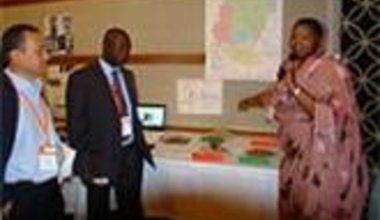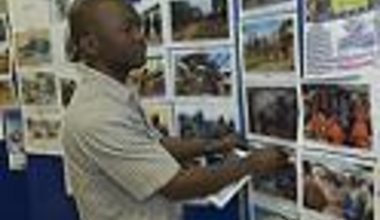Armed with clean sheets of paper and pencils, teenagers were drawing clouds, trees and solid houses in central Omdurman's Felah Centre before returning to the streets, where most of them lived.
"We come from the street," said 17-year-old Ibtisam Mohammed, a lanky girl dressed in colourful clothes, with a scarf holding up her abundant hair.
Ibtisam, originally from Babanusa in Southern Kordofan State, was attending
the "mobile library", organized by the Sabah Association for Child Welfare and Development every Thursday and Saturday, along with 20 other young people.
Sabah is a Sudanese non-governmental organization (NGO) that has been providing services to street children in greater Khartoum since 1985. Executive Director Khalaf Alla Ismail said the project was launched by Sudanese volunteers wanting to support the hundreds of idle and hungry children roaming around markets after the western Sudan drought of 1984-85.
At that time, many children moved to the federal capital with their families and were forced to work, beg or steal on the streets, pushing the number of street children in Khartoum to more than 12,000, according to a Ministry of Social Welfare survey.
Since then, the number had increased, as political conflicts, poverty and broken families continued to force children onto the streets, said Mr. Ismail.
According to the 2001 study "Children of the Sug: Full-time and working street children of Khartoum, Sudan", an estimated 35,000 unaccompanied children were on the streets of Khartoum. A collaboration of international NGOs and UNICEF, the study showed that about 80 per cent had homes to return to at day's end, while about 20 per cent were believed to spend both day and night on the streets.
Nineteen-year-old Mazeed Mahmoud, a native of Dilling in the Nuba Mountains, who has been living in Khartoum since he was nine, said he polished shoes and worked as a conductor on minibuses to support his family. But he went home to his mother and four siblings for the night.
"I am the oldest one," Mazeed said, as he finished up his drawing of a kindergarten surrounded by trees at the Felah Centre, adding that he felt responsible for his siblings.
Broken families and empty pockets
Children mainly took to the streets due to problems at home, parents without formal schooling, poverty and broken families, according to Ministry of Social Welfare psychologist and social worker Hala Rashid.
Frequently, when a parent remarried after the other parent's death or divorce, the new partner failed to accept children from the first marriage, Ms. Rashid said.
"The new parents are often violent with the children, drive them away and sometimes mistreat them," the psychologist said, adding that the trauma often led to glue-sniffing addictions.
Roaming the streets often implies children are in trouble, according to social workers. The Juvenile Welfare Act 1983 defined homelessness as a crime punishable by 20 lashes until the Child Act of 2004 and then 2010 decriminalized it. However, children still often end up at police stations for sniffing glue or vagrancy.
One way of discouraging children from substance abuse was to warn them about the possible health risks, Ms. Rashid said, and keep them occupied.
Following this philosophy, the Mohabem Children's Centre was founded in Omdurman in 1997 by the Presbyterian and Evangelical Church as a drop-in centre where children could take a shower and receive a meal.
Since then, the church has established a centre in Khartoum's Gireif area, Renk, Upper Nile State and Nyala, South Darfur State. The idea at the Gireif live-in centre, which currently houses 20 boys, was to "keep them (the youth) busy", so they would stop sniffing glue, said a volunteer there, who did not wish to be named.
The centre also offered schooling and meals as well as mechanic and carpentry workshops for young men aimed at "realigning their identities", the volunteer said. "We are trying to show them unconditional love," making the boys believe that "being a thief is not my identity".
The hardest part was "learning how to stay in one place", said 20-year-old Maurice Pagan Deng at the Gireif shelter. "The workshops are the best thing, and that we can go to school."
Although the Sudanese government ran several large centres around the capital accommodating hundreds of homeless children, many social workers felt it was best to avoid institutionalizing individuals.
According to the "Children of the Sug", the governmental centres focused on "reforming children psychologically and socially through military-like discipline". Hence, children often escaped them to return to the streets.
"Many kids feel detained in residential centres and prefer to live outside," said Sabah social worker Ahmed Ali, who was trying to make youngsters feel more secure in a thatched shelter in a quiet Omdurman neighbourhood, before they hit the bustling streets again.
 UN
UN United Nations Peacekeeping
United Nations Peacekeeping





